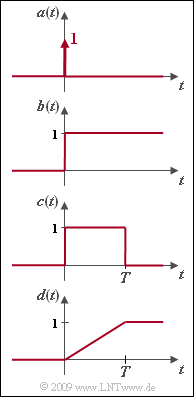Difference between revisions of "Aufgaben:Exercise 3.2Z: Laplace and Fourier"
| Line 12: | Line 12: | ||
For power-limited signals – characteristics: infinite energy – $X(f)$ also includes distributions (Dirac functions). | For power-limited signals – characteristics: infinite energy – $X(f)$ also includes distributions (Dirac functions). | ||
| − | + | For all causal signals (and only for these), the Laplace transformation is applicable: | |
:$$X_{\rm L}(p) = \int_{0}^{ | :$$X_{\rm L}(p) = \int_{0}^{ | ||
\infty} | \infty} | ||
Revision as of 23:49, 10 October 2021
The Fourier transformation can be applied to any deterministic signal $x(t)$ . Then, the following holds for the spectral function:
- $$X(f) = \int_{-\infty}^{ +\infty} { x(t) \hspace{0.05cm}\cdot \hspace{0.05cm} {\rm e}^{-{\rm j}\hspace{0.05cm}\cdot \hspace{0.05cm}2\pi f t}}\hspace{0.1cm}{\rm d}t\hspace{0.05cm}\hspace{0.05cm} .$$
For power-limited signals – characteristics: infinite energy – $X(f)$ also includes distributions (Dirac functions).
For all causal signals (and only for these), the Laplace transformation is applicable:
- $$X_{\rm L}(p) = \int_{0}^{ \infty} { x(t) \hspace{0.05cm}\cdot \hspace{0.05cm} {\rm e}^{-p t}}\hspace{0.1cm}{\rm d}t\hspace{0.05cm}\hspace{0.05cm} .$$
In the diagram you can see several causal time functions that will be covered in this exercise:
- the Dirac function $a(t)$,
- the step function $b(t)$,
- the rectangular function $c(t)$,
- the ramp function $d(t)$.
The Fourier transform theorems gelten meist (allerdings nicht immer) auch für die Laplace–Transformation, wobei $p ={\rm j} \cdot 2 \pi f$ zu setzen ist:
- Zum Beispiel lautet der shifting theorem in Laplace– bzw. Fourier–Darstellung:
- $$x(t- \tau) \quad \circ\!\!-\!\!\!-^{\hspace{-0.25cm}\rm L}\!\!\!-\!\!\hspace{-0.05cm}\bullet\quad X_{\rm L}(p)\cdot {\rm e}^{-p \hspace{0.05cm} \cdot \hspace{0.05cm}\tau}\hspace{0.05cm} ,$$
- $$x(t- \tau) \quad \circ\!\!-\!\!\!-^{\hspace{-0.05cm}}\!\!\!-\!\!\hspace{-0.05cm}\bullet\quad X(f)\cdot {\rm e}^{-{\rm j}\hspace{0.05cm} \cdot \hspace{0.05cm}2\pi f \hspace{0.05cm} \cdot \hspace{0.05cm}\tau}\hspace{0.05cm} .$$
- Dagegen ergeben sich beim integration theorem Unterschiede:
- $$\int {x(\tau)} \hspace{0.1cm}{\rm d}\tau \quad \circ\!\!-\!\!\!-^{\hspace{-0.25cm}\rm L}\!\!\!-\!\!\hspace{-0.05cm}\bullet\quad X_{\rm L}(p)\cdot \frac{1}{p}\hspace{0.05cm} ,$$
- $$\int {x(\tau)} \hspace{0.1cm}{\rm d}\tau \quad \circ\!\!-\!\!\!-^{\hspace{-0.05cm}}\!\!\!-\!\!\hspace{-0.05cm}\bullet\quad X(f)\cdot \left [ {1}/{2} \cdot{\rm \delta } (f) + \frac{1}{{\rm j} \cdot 2\pi f} \right ] \hspace{0.05cm} .$$
Please note:
- The exercise belongs to the chapter Laplace Transform and p-Transfer Function.
- Das Lernvideo Fourier transform theorems könnte hilfreich sein .
Questions
Solution
- Berücksichtigt man, dass die Diracfunktion nur bei $t= 0$ ungleich Null ist und das Integral über den Dirac den Wert $1$ liefert, solange das Integrationsintervall den Zeitpunkt $t= 0$ einschließt, so erhält man:
- $$A(f) = 1, \hspace{0.2cm}A_{\rm L}(p) = 1 \hspace{0.05cm} .$$
(2) Richtig sind wieder die Lösungsvorschläge 1 und 3:
- Die Sprungfunktion $b(t) = \gamma(t)$ ist das Integral über die Diracfunktion $a(t) = \delta(t)$ ⇒ man kann den integration theorem anwenden:
- $$b(t) = \int_{-\infty}^t {a(\tau)} \hspace{0.1cm}{\rm d}\tau \hspace{0.3cm}\Rightarrow \hspace{0.3cm} B_{\rm L}(p) =A_{\rm L}(p)\cdot {1}/{p} = {1}/{p}\hspace{0.05cm} ,$$
- $$B(f) = A(f)\cdot \left [ {1}/{2} \cdot{\rm \delta } (f) + \frac{1}{{\rm j} \cdot 2\pi f} \right ] = {1}/{2} \cdot{\rm \delta } (f) + \frac{1}{{\rm j} \cdot 2\pi f}\hspace{0.05cm} .$$
(3) Richtig sind die Lösungsvorschläge 2 und 3:
- Nachdem die (kausale) Rechteckfunktion als Differenz zweier Sprungfunktionen dargestellt werden kann, erhält man mit dem shifting theorem:
- $$c(t)= b(t) - b(t-T) \hspace{0.3cm} \Rightarrow \hspace{0.3cm} C_{\rm L}(p) =B_{\rm L}(p)- B_{\rm L}(p) \cdot {\rm e}^{-p \hspace{0.05cm} \cdot \hspace{0.05cm}T} = {1}/{p} \cdot \big [ 1- {\rm e}^{-p \hspace{0.05cm} \cdot \hspace{0.05cm}T} \big ] \hspace{0.05cm} .$$
- Da die Rechteckfunktion eine endliche Energie besitzt, gilt für das Fourier spectrum:
- $$C(f) = C_{\rm L}(p)\Bigg |_{\hspace{0.1cm} p\hspace{0.05cm}=\hspace{0.05cm}{\rm j \hspace{0.05cm}2\pi \it f}} = \frac{1}{{\rm j} \cdot 2\pi f} \cdot \big [ 1- {\rm e}^{-{\rm j} \hspace{0.05cm}\cdot \hspace{0.05cm} 2\pi f T} \big ] \hspace{0.05cm}.$$
- Nach einigen trigonometrischen Umformungen kann hierfür auch geschrieben werden:
- $$C(f) = T \cdot {\rm si} (2 \pi f{T})+ {\rm j} \cdot \frac{{\rm cos} (2 \pi f{T})-1}{2\pi f} \hspace{0.05cm}.$$
(4) Richtig ist der Lösungsvorschlag 1, da gilt:
- $$d(t) = \frac{1}{T} \cdot \int\limits_{-\infty}^t {c(\tau)} \hspace{0.1cm}{\rm d}\tau \hspace{0.3cm}\Rightarrow \hspace{0.3cm} D_{\rm L}(p) =C_{\rm L}(p)\cdot \frac{1}{p \cdot T} = \frac{1- {\rm e}^{-p \hspace{0.05cm}\cdot \hspace{0.05cm}T}}{p^2 \cdot T}\hspace{0.05cm} .$$
- Da sich $d(t)$ bis ins Unendliche erstreckt, ist der einfache Zusammenhang zwischen $D_{\rm L}(p)$ und $D(f)$ gemäß Lösungsvorschlag 3 nicht gegeben.
- $D(f)$ beinhaltet vielmehr auch eine Diracfunktion bei der Frequenz $f = 0$.
